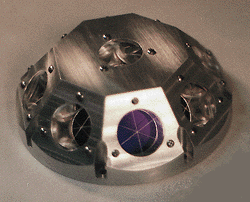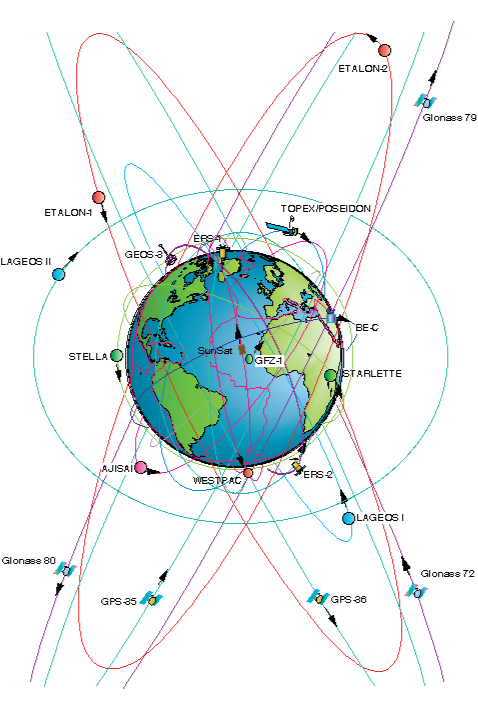Satellite Laser Ranging
Accurately timing short laser pulse return journeys to satellites carrying retro-reflector targets.
SLR can achieve range measurements to a variety of different scientific satellites ranging in height from 300km to 42 000km to an accuracy of approximately 1cm. This requires state-of-the-art technology and a consistently calibrated system.
The SGF can operate one of two different lasers to generate the laser pulses. This is done by the excitation of energy levels in either a solid-state Nd:YAG crystal or a Nd:VAN semiconductor. These pulses are extremely short in duration (100 picoseconds and 10ps respectively). This enables precise range measurements but also makes the lasers highly powered at levels of 100s of MW/cm2.

Courtesy of HTSI
The pulse travels through the Earth's atmosphere and is refracted by the changing air mass density. It illuminates the entire satellite which is carrying an array of retro-reflector cubes. These optical assemblies are comprised of three reflective faces at near right angles in order to redirect incident light back to its origin.
The returning light is again refracted by the atmosphere and casts a 'footprint of light' around the SGF, part of which is collected by the SLR telescope. The light is focussed on the single-photon avalanche diode (SPAD) detector and a 'stop' is recorded, with a jitter of approximately 20ps . The vast majority of the millions of billions of photons in each laser pulse are lost and only a few returning photons are detected.
 These 'starts' and 'stops' are accurately determined by an epoch timer and, using the speed of light, the interval between a matched pair gives the 2-way range measurement.
These 'starts' and 'stops' are accurately determined by an epoch timer and, using the speed of light, the interval between a matched pair gives the 2-way range measurement.The single wavelength property of the laser light, 532nm, allows the facility to operate day or night by filtering out noise, including daylight, using a very narrow spectral filter so that only the green laser light reaches the detector.
In order to account for system delays in the measured ranges, regular calibrations are made to a target constructed of two flat metal panels at a right angle, positioned approximately 130 metres away. This distance was precisely surveyed, from the centre of the target to the centre, invariant, point of the telescope. This terrestrial range to a known distance allows the removal of the electronic and optical delays in the laser bed and timing system. This target distance is regularly measured to account for temperature variations.
The high altitude satellites tracked by the SGF take several hours to pass overhead. The LAGEOS satellites take about 45 minutes and the lower satellite take between 5-10 minutes. The SLR telescope can only track one satellite at a time and so fast switching between satellites allows an efficient use of the system to get as much data from as many satellites as possible. The SLR is dependent on clear skies and the local weather is closely monitored by observers to ensure otherwise continuous operation.
The SLR station at the SGF is unique in the UK and a major system in the International Laser Ranging Service (ILRS) global network of around 40 SLR stations. These stations track the same satellites over different points on the Earth’s surface. The data produced is used by the satellite mission providers and the analyst community.

